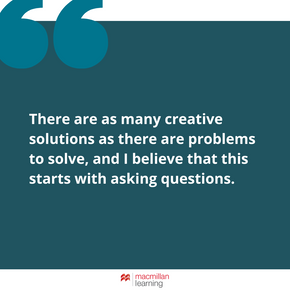-
About
Our Story
back- Our Mission
- Our Leadershio
- Accessibility
- Careers
- Diversity, Equity, Inclusion
- Learning Science
- Sustainability
Our Solutions
back
-
Community
Community
back- Newsroom
- Webinars on Demand
- Digital Community
- The Institute at Macmillan Learning
- English Community
- Psychology Community
- History Community
- Communication Community
- College Success Community
- Economics Community
- Institutional Solutions Community
- Nutrition Community
- Lab Solutions Community
- STEM Community
- Newsroom
- Macmillan Community
- :
- Newsroom
- :
- Learning Stories Blog
- :
- The 5 C’s: A Teamwork Approach to Success in the N...
The 5 C’s: A Teamwork Approach to Success in the New Year
- Subscribe to RSS Feed
- Bookmark
- Subscribe
- Printer Friendly Page
- Report Inappropriate Content
With the end of the year quickly approaching, I have been reflecting on the building blocks of my team’s success in 2022. Success happens when we all seek to develop effective leadership skills. As a way to center my team and create an even more inclusive environment for working and leading together, I introduced 5 key qualities for success: Collaboration, Communication, Curiosity, Creativity, and Co-elevation. I have since seen the team flourish. These qualities have helped us learn and grow, and they are what drive the best team in the industry--from the seasoned veterans to the emerging learners.
Collaboration means working together in new ways and getting diverse perspectives. In the past year, I have seen my colleagues continue to hone their skills in working remotely and learning from one another in ways we could not have imagined just a few years ago. We have mastered the new tools that bring us together virtually (hat tip to you Jamboard, Slack, Google Meet, and Mural!), yet we have embraced opportunities to meet in person again (yes there was hugging!). These reunions provided so much joy and helped us exercise some muscles we hadn’t used in a while. Being together definitely fuels our engines.
Communication means exchanging new ideas, information, and understandings. I recently spent time with our newest editorial team members honing these skills, inspired by Erica Dhawan’s, Digital Body Language. Dhawan wrote, “These days, we don’t talk the talk or even walk the talk. We write the talk.” Her book underscores the importance of written communication and making a continuous effort to minimize the risk of misunderstanding. Communicating carefully empowers us to collaborate confidently. Start with a simple step to improve your communication: identify your preferred method of communicating, and ask your closest team members about theirs. Their answers may surprise you!
Curiosity means asking questions and seeking out answers. Curiosity is what gets me out of bed in the morning. What challenges will we face today? How can we work to help students and educators be more successful? At the National Council for the Social Studies conference earlier this month, I was inspired by teachers seeking ways to expand their toolbox for supporting students. We talked about the realities of learning loss as students missed essential school experiences during the pandemic. One teacher mentioned handwriting as an obstacle to success now that students have returned to classrooms. It was a light bulb moment for me when she said, “I don’t know if they even picked up a pen during the whole pandemic!” It has helped me move away from thinking too big; instead, I’m asking more questions about incremental support we could offer. How can we best help students gain skills? How can we help them practice in a way that will elevate their learning?

Co-elevation is a superpower I continue to look to sharpen. I first learned about this concept in Keith Ferrazzi’s Leading Without Authority. Co-elevation means working together with colleagues from different departments, with different skill sets, at different levels, with different backgrounds (and likely different preferences for communicating!), and regardless of managerial reporting lines, to accomplish what otherwise may have been impossible. This concept defies long-held best practices in the workplace of answering to one manager and following one leader on a straight path to completing a goal. Self-forming teams co-elevate using the first 4 C’s (Collaboration, Communication, Curiosity, and Creativity) to solve today’s challenges with their diverse, collective expertise and ideas. These nimble, cross-functional teams share a passion and a mission to reach new levels of success through trust and caring. I see co-elevation at work every day, best exemplified by the finalists in our 2022 Innovation Tournament. Diverse groups of colleagues co-elevated to improve efficiency, products, our customer’s experience, and our company culture and further motivated all of us toward these goals.
Like an athlete who has to practice regularly to stay in shape, we all need to exercise our muscles to strengthen these important qualities, especially as we think ahead to the goals we want to achieve in the year ahead. What leadership qualities do you want to exercise for success in the new year? Which one of the 5 C’s would best help you achieve your goals?

